A Sweet Discovery From My Bright Kitchen
Welcome to EatBrightly, where every recipe is created with curiosity, joy, and a deep love for food that does more than fill your plate. It fuels your body and uplifts your spirit. I’m Mia Langston, and today I’m inviting you into my Asheville kitchen to explore something creamy, satisfying, and surprisingly nutritious: cottage cheese cookie dough.
To be honest, cottage cheese wasn’t always one of my favorite ingredients. Growing up in upstate New York, cookie dough meant flour, sugar, and plenty of sneaky spoonfuls when Mom wasn’t looking. But over the years, as I explored cleaner, more nourishing ways to recreate my favorite comfort foods, I realized real-food swaps can be just as satisfying as the originals. This recipe proves it.
This article covers everything you need to know about making this high-protein, no-bake treat that’s been trending in health circles and kitchens everywhere. We’ll take a look at why cottage cheese works so well in cookie dough, how to blend it for the best texture, and all the delicious ways you can customize it. You’ll also find helpful tips on storing, balancing macros, and even avoiding common mistakes that can ruin the texture.
Whether you’re craving something sweet, looking for a post-workout snack, or just curious about trying something new, you’re in the right place.
Discover great ideas like these high protein cottage cheese recipes that support your fitness goals
Tables of Content
Table of Contents
What is Cottage Cheese Cookie Dough?
Understanding the Trend Behind Cottage Cheese Cookie Dough
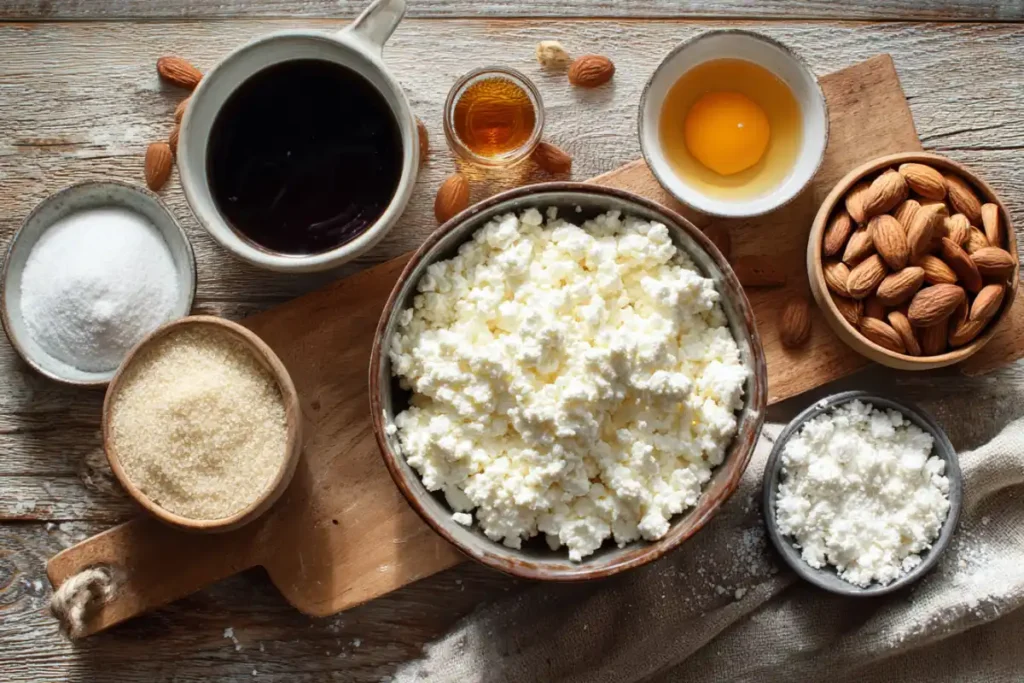
Cottage cheese cookie dough might sound like an unusual combination, but it’s quickly become one of the most buzzworthy trends in the health and wellness world. Why? Because it offers a guilt-free way to enjoy edible cookie dough while packing in a solid dose of protein and nutrients. Social media, especially TikTok and Instagram, have played a major role in spreading this creamy, dreamy creation. With just a few ingredients and no baking required, it’s the kind of snack that feels indulgent but supports your health goals.
Unlike traditional cookie dough, which is loaded with raw eggs, white sugar, and processed flour, this version blends creamy cottage cheese with wholesome ingredients like almond flour, maple syrup, vanilla extract, and chocolate chips. The result? A sweet, spoonable treat that’s safe to eat raw and surprisingly satisfying.
Why Cottage Cheese Is a Surprising Yet Perfect Base
Cottage cheese might not be the first thing that comes to mind when you think “dessert,” but it’s actually ideal for this kind of recipe. Its creamy consistency, especially when blended, mimics the smoothness of traditional dough. Plus, it’s mild in flavor, making it easy to pair with other sweet ingredients without overpowering them.
It also brings a nutrient-rich punch to your treat. Cottage cheese is high in casein protein, which digests slowly and keeps you full longer. It’s also low in sugar, rich in calcium, and contains gut-friendly probiotics when you choose the right brand. All of these factors make it a powerhouse choice for anyone seeking to snack smartly without giving up dessert.
Nutritional Profile: High Protein, Low Sugar
When compared to traditional cookie dough, cottage cheese cookie dough stands out for its impressive nutrition stats. Most versions contain:
| Nutrient | Approx. Amount per Serving |
|---|---|
| Protein | 10–15g |
| Sugar | 2–4g (from natural sweeteners) |
| Calories | 150–200 |
| Carbs | 5–10g |
| Fat | 6–10g |
This makes it a great option for those watching their sugar intake, building muscle, or simply looking for a more balanced treat.
Not sure about the difference between casein and whey in cottage cheese? The healthline explains that cottage cheese is rich in casein, which digests slowly and supports muscle repair and longer-lasting satiety.
Benefits of Using Cottage Cheese in Cookie Dough
High Protein for Muscle Recovery and Satiety
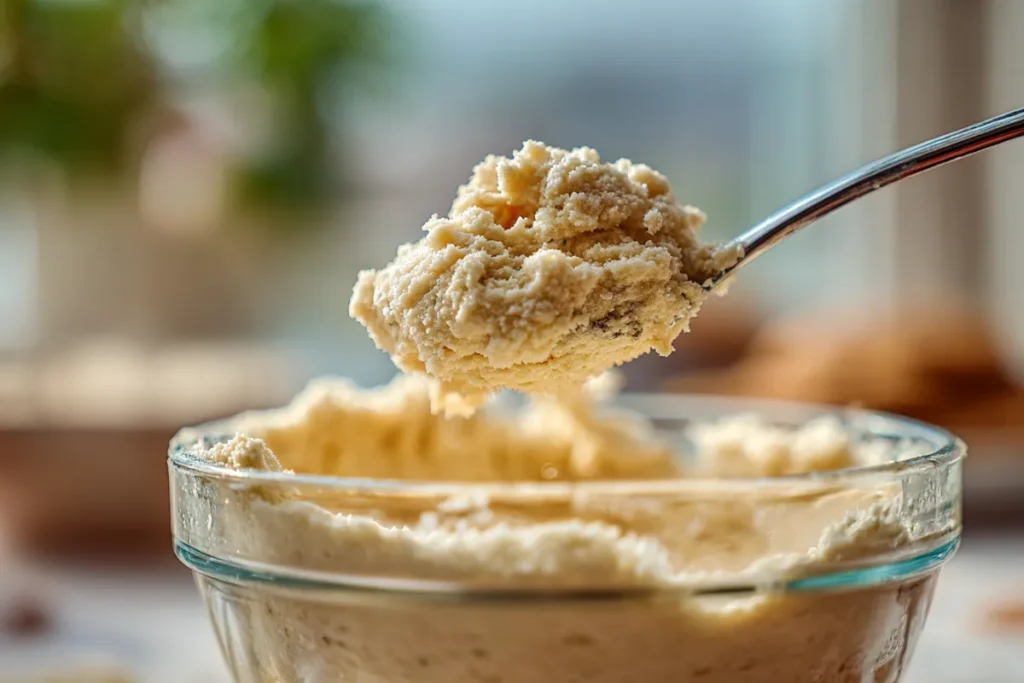
One of the top reasons people are swapping traditional cookie dough for a cottage cheese version is protein. Cottage cheese is naturally rich in casein, a slow-digesting protein that helps repair muscles, reduce hunger, and stabilize blood sugar levels. When blended into cookie dough, it transforms a sweet craving into a functional snack.
This makes cottage cheese cookie dough a great post-workout bite or mid-afternoon pick-me-up. Paired with almond flour or a scoop of vanilla protein powder, each serving can deliver 12 to 20 grams of protein without any artificial ingredients.
Low-Fat, Gut-Friendly, and Nutrient-Rich
Unlike heavy creams or butter typically found in traditional doughs, cottage cheese is low in fat but still creamy enough to satisfy. It’s also packed with essential nutrients like calcium, phosphorus, and B vitamins. If you choose a probiotic-rich variety, you’re also supporting gut health while indulging in dessert.
Many lactose-sensitive eaters find that blended cottage cheese is easier to digest, especially in small portions. And since it’s naturally low in sugar, it fits well into low-carb, keto, or diabetic-friendly diets when paired with the right ingredients.
Gluten-Free and Egg-Free Alternatives
If you’re avoiding gluten or eggs, this cookie dough is a win. Almond flour or oat flour replaces traditional wheat flour, while cottage cheese binds everything together without needing raw eggs. That makes it not only safer to eat raw but also more accessible for people with food allergies or sensitivities.
Cottage cheese cookie dough is naturally gluten-free and easily adaptable for dairy-free or plant-based diets using alternatives like almond-based “cheeses.”
How to Make Cottage Cheese Cookie Dough at Home
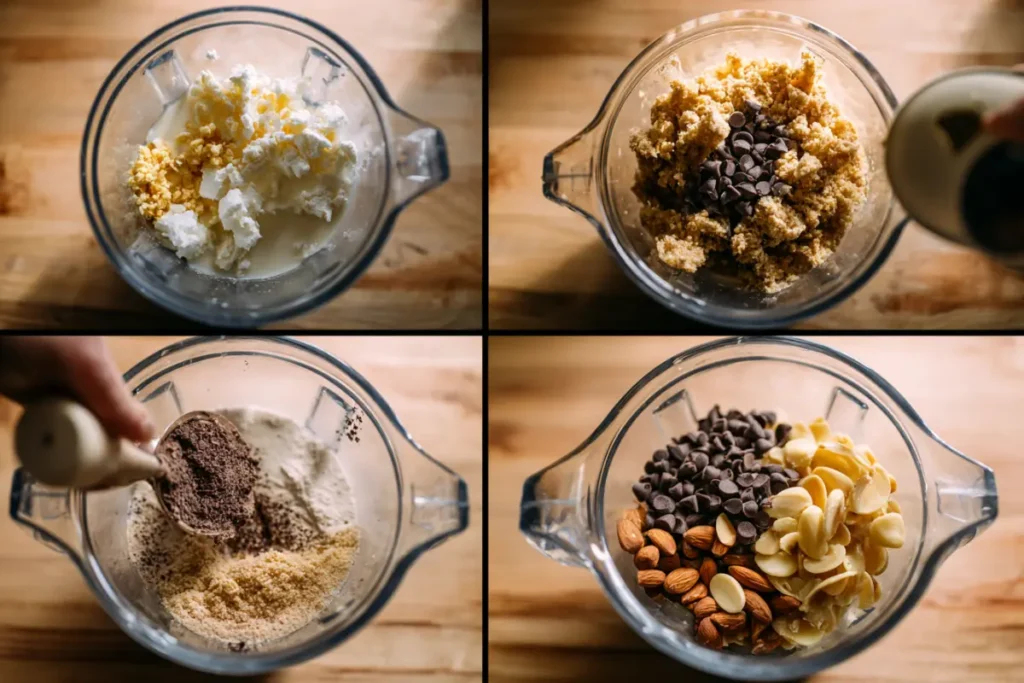
Basic 5-Ingredient Version
Making cottage cheese cookie dough at home is surprisingly simple. Most recipes require just five to six wholesome ingredients, many of which you probably already have in your pantry. Here’s a basic blueprint to get you started:
Ingredients:
- 1 cup low-fat cottage cheese
- 2 tablespoons maple syrup (or honey for variation)
- 1 teaspoon vanilla extract
- 1 ½ cups almond flour
- ½ cup chocolate chips (dairy-free or dark chocolate if preferred)
Optional: Add 1–2 tablespoons of protein powder for an extra boost.
This recipe creates a smooth, sweet, and spoonable dough that’s safe to eat right out of the bowl. Best of all, it takes less than 10 minutes from start to finish.
Tools and Preparation Techniques
All you need is a blender or food processor, a mixing bowl, and a spatula. Blending is key to turning the curds of cottage cheese into a smooth, creamy base that mimics classic cookie dough texture.
Steps:
- Blend the cottage cheese, maple syrup, and vanilla extract until smooth and fluffy.
- In a mixing bowl, stir together the almond flour and protein powder (if using).
- Fold the dry mixture into the cottage cheese blend. Mix until fully combined.
- Stir in the chocolate chips.
- Chill for 10–15 minutes before serving for firmer texture (optional).
If you don’t have a food processor, a high-speed blender works fine. Just scrape down the sides often to avoid any graininess.
Blending Tips for Creamy Texture
To avoid a lumpy or watery base, always use full-fat or low-fat cottage cheese—not fat-free. The added creaminess makes a big difference. Be sure to blend long enough to smooth out any curds completely.
Here are a few pro tips:
- Drain excess liquid from the cottage cheese before blending for a thicker consistency.
- Use a silicone spatula to scrape every last bit out of your blender.
- Chill before serving for a firmer, more dough-like bite.
Variations and Add-Ins to Try
Vegan and Dairy-Free Alternatives
While traditional cottage cheese is dairy-based, it’s easy to customize this recipe for plant-based eaters. Vegan cottage cheese made from almonds, cashews, or soy can be found in most health food stores, and they blend beautifully into edible dough. Choose unsweetened varieties to control the flavor and sweetness.
For even more plant-based power, consider these swaps:
- Use maple syrup or agave as your sweetener.
- Add nut butters like almond or sunflower for richness.
- Mix in dairy-free chocolate chips for a completely vegan dessert.
These simple substitutions ensure everyone at your table can enjoy a creamy, protein-packed cookie dough no dairy needed.
Chocolate Chip, Peanut Butter, and More
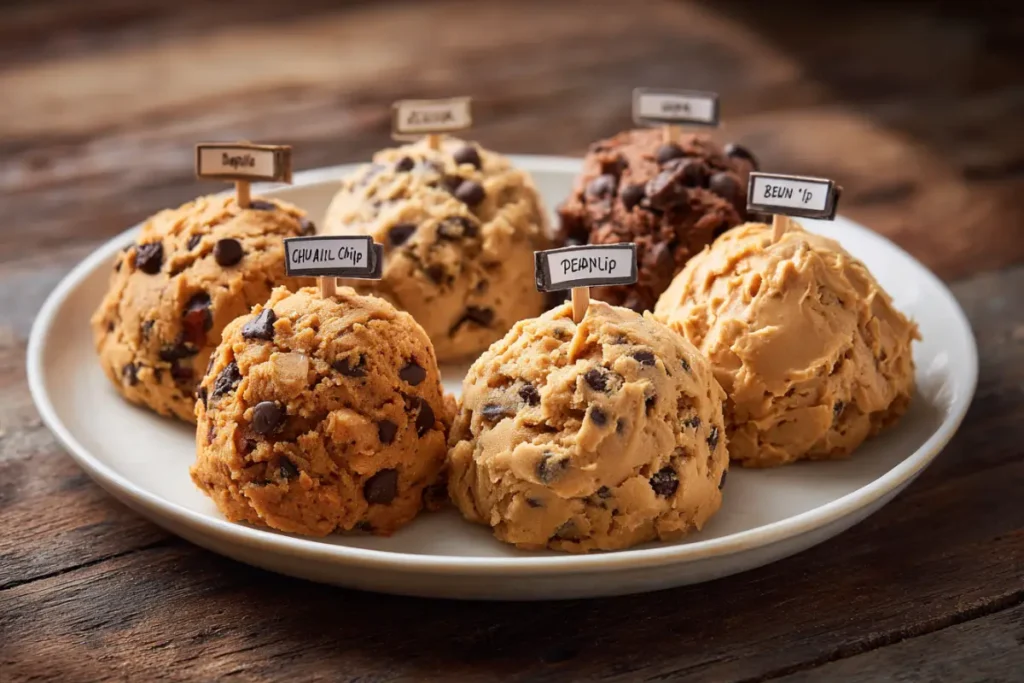
The flavor possibilities for cottage cheese cookie dough are endless. Once you have your base, try mixing and matching your favorite add-ins to create new flavor profiles. Here are some top combinations:
| Flavor Combo | Add-Ins |
|---|---|
| Chocolate Peanut Butter | 1 tbsp peanut butter + cocoa nibs or chips |
| Birthday Cake | Natural sprinkles + almond extract |
| Cinnamon Raisin | 1 tsp cinnamon + 2 tbsp raisins |
| Mocha Chip | 1 tsp instant espresso + dark chocolate chunks |
| Salted Caramel | Sugar-free caramel sauce + pinch of sea salt |
You can also roll the dough into bite-sized balls and freeze them for grab-and-go snacks. They’re perfect for lunchboxes, post-workout fuel, or late-night cravings.
Sweeteners: Maple Syrup, Stevia, or Dates?
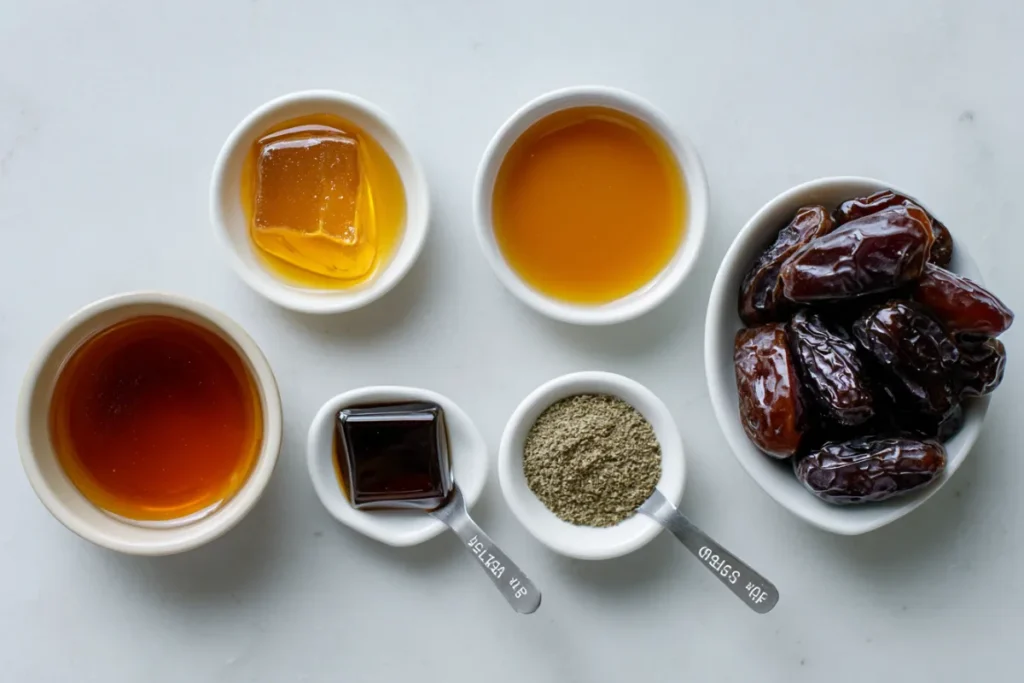
Sweeteners make a big difference in both taste and texture. Maple syrup adds a rich, earthy flavor, while honey brings a floral note. If you’re watching sugar intake, liquid stevia, monk fruit syrup, or blended dates are excellent alternatives.
Here’s a quick guide to choosing the right sweetener:
| Sweetener | Sweetness Level | Best For |
|---|---|---|
| Maple Syrup | Medium | Balanced sweetness & smoothness |
| Honey | High | Floral, dense textures |
| Dates (blended) | Medium-High | Whole food, thicker consistency |
| Monk Fruit | High | Sugar-free, low-carb diets |
| Stevia Drops | Very High | Diabetic-friendly, low calorie |
Cottage Cheese Cookie Dough and Fitness Goals
Post-Workout Snack or Meal Replacement?
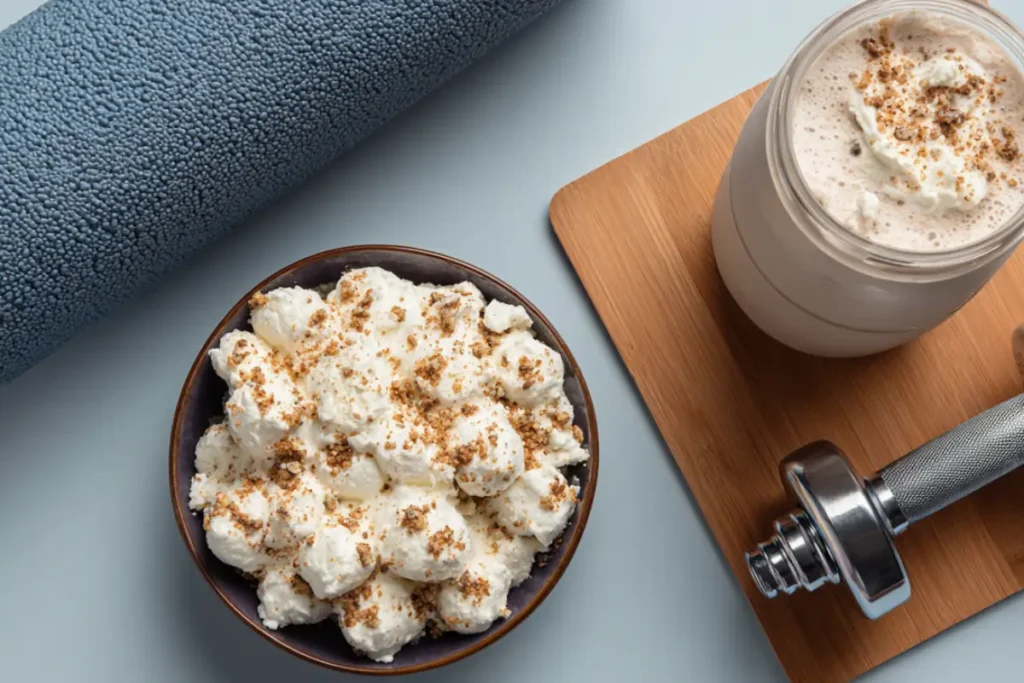
If you’ve ever searched for a protein-rich treat that satisfies your sweet tooth without undoing your workout gains, this is it. Cottage cheese cookie dough is more than just a trendy dessert—it’s a functional food that can help support your fitness and recovery goals.
With a balanced mix of slow-digesting casein protein, healthy fats from nut flours, and optional complex carbs from add-ins like oats or dates, this dough doubles as a post-workout snack or light meal replacement. The protein content promotes muscle repair, while the creamy texture helps you feel full longer.
Whether you’re lifting, cycling, hiking, or just staying active with your daily routine, this dough fits easily into any recovery window.
If you’re wondering why protein matters so much when building a snack like cottage cheese cookie dough, Harvard Health explains it well. Protein plays a vital role in muscle maintenance, satiety, and metabolism.
Balancing Macros with Protein Powder
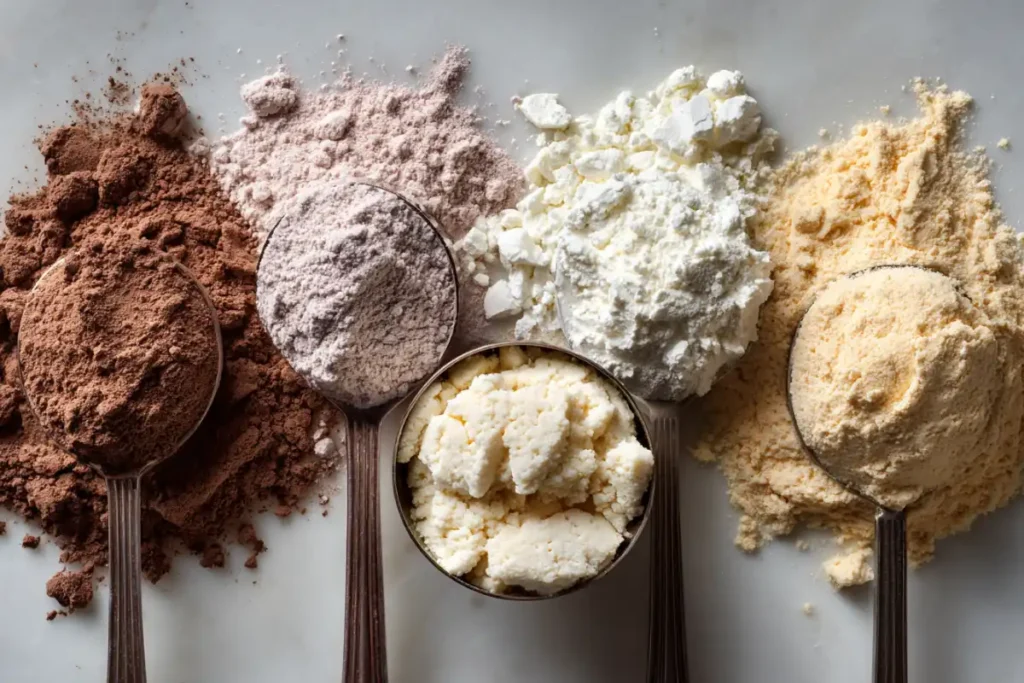
Want to dial in your macros for your specific goals? Adding protein powder to your cottage cheese cookie dough is a smart and simple way to level up your nutrition. Just be sure to choose a clean, minimally processed protein with a flavor that complements your ingredients.
Here’s how different protein types affect the outcome:
| Protein Powder Type | Flavor/Texture Impact | Best Use Case |
|---|---|---|
| Whey (Isolate) | Light, creamy, fast-absorbing | Lean muscle gain, post-workout |
| Casein | Thick, slow-digesting | Overnight snacking, meal replacement |
| Vegan (Pea/Rice blend) | Earthy, slightly grainy if overused | Plant-based diets |
| Collagen | Neutral taste, less thickening | Skin/joint support, low-carb diets |
Start with 1–2 tablespoons and blend well to avoid clumping. If the dough becomes too dry, simply add a splash of almond milk or extra cottage cheese to smooth it out.
Cottage Cheese vs Greek Yogurt for Protein
You might be wondering: can’t I just use Greek yogurt instead? Sure, but here’s why cottage cheese often wins:
- Higher in casein protein, which digests more slowly and keeps you full longer
- Thicker consistency when blended, giving the dough a more authentic texture
- Lower in sugar (especially in plain versions)
- Often higher in overall protein per ounce compared to yogurt
That said, both are excellent choices depending on your goals and taste preferences. If you love the tangy flavor of Greek yogurt, give it a try. But for a rich, creamy dough with that authentic cookie feel, cottage cheese is the go-to.
Storage, Safety & Shelf Life
How Long Can You Store Cottage Cheese Cookie Dough?
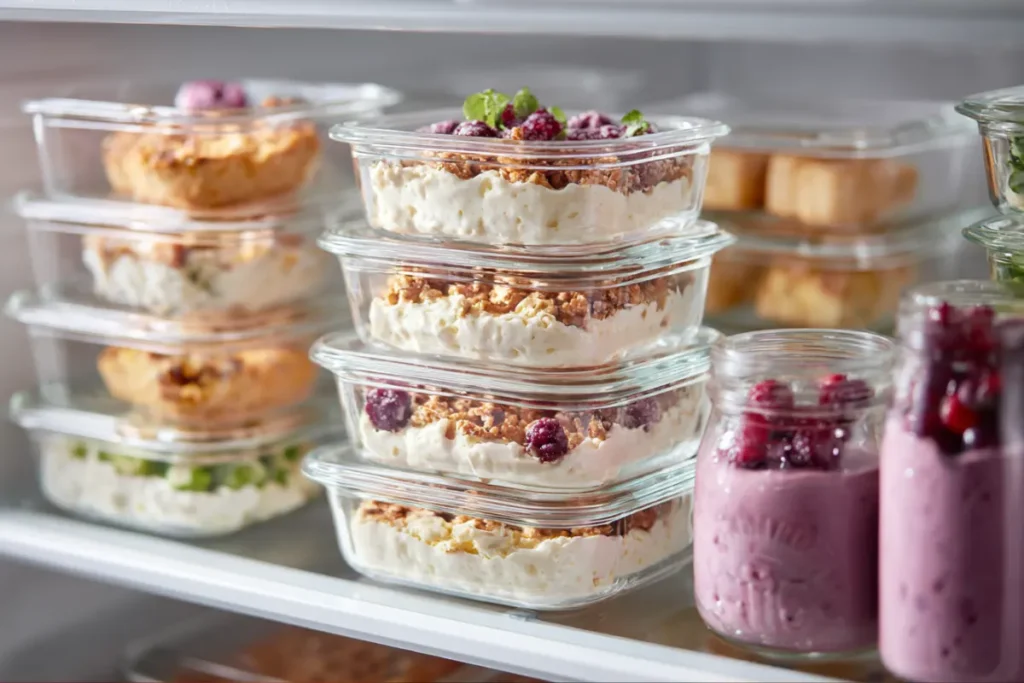
Cottage cheese cookie dough is made with fresh dairy, so while it’s incredibly satisfying, it also requires smart storage to stay safe and delicious. When stored properly, it can last up to 4–5 days in the refrigerator. For best results, keep it in an airtight glass container to maintain freshness and prevent the dough from absorbing other fridge odors.
If you’re meal-prepping or making a large batch, portion the dough into single servings to avoid repeatedly opening the main container. This also helps reduce the risk of bacterial contamination.
Best Storage Containers & Tips
Proper storage starts with the right container. Here’s what we recommend:
| Container Type | Pros | Cons |
|---|---|---|
| Glass with lid | Airtight, BPA-free, long-lasting | Slightly heavier |
| Silicone snack cups | Great for portioning, flexible | Not always fully sealed |
| Mason jars | Cute, airtight, reusable | May take up more space |
| Plastic meal prep | Lightweight, stackable | Can stain or retain odors |
A good tip: place a layer of parchment paper on top of the dough before sealing the container. This reduces exposure to air and helps preserve texture.
To serve, simply scoop it out cold, or let it sit for 5 minutes at room temperature for a softer consistency.
Signs of Spoilage to Watch Out For
Even refrigerated, cottage cheese cookie dough doesn’t last forever. Always give it a quick look and sniff before digging in. Watch for:
- Sour or off smell – fresh cottage cheese should smell clean and neutral
- Separation or excessive liquid – slight separation is okay, but too much liquid is a red flag
- Mold spots or discoloration – if it’s not the original dough color, toss it
When in doubt, throw it out. Eating spoiled dairy can lead to digestive issues, so it’s not worth the risk.
Common Mistakes to Avoid
Over-Blending or Under-Mixing
One of the most common pitfalls when making cottage cheese cookie dough is mishandling the blending process. Over-blending can make the mixture too runny, stripping it of that satisfying dough-like texture. On the other hand, under-mixing can leave visible curds, which ruin the smoothness and consistency.
Tip: Blend only until the mixture becomes creamy and uniform no longer than 30–45 seconds in a high-speed blender. Stop and scrape down the sides to ensure everything is evenly incorporated.
For the dry ingredients, mix thoroughly with a spatula or spoon to prevent clumping. This ensures your dough is smooth, scoopable, and has that classic, indulgent texture.
Choosing the Wrong Type of Cottage Cheese
Not all cottage cheese is created equal. Choosing the wrong type can leave you with a grainy, watery, or overly tangy dough. Avoid fat-free or large-curd versions they often don’t blend well and can make your dough feel gritty.
Best Choice: Go for low-fat or full-fat small-curd cottage cheese, preferably organic or grass-fed if available. These options give you the richest flavor and creamiest base without being too heavy.
If you’re dairy-sensitive, opt for plant-based cottage cheese alternatives that are unsweetened and blend easily.
Why Texture Matters in Edible Cookie Dough
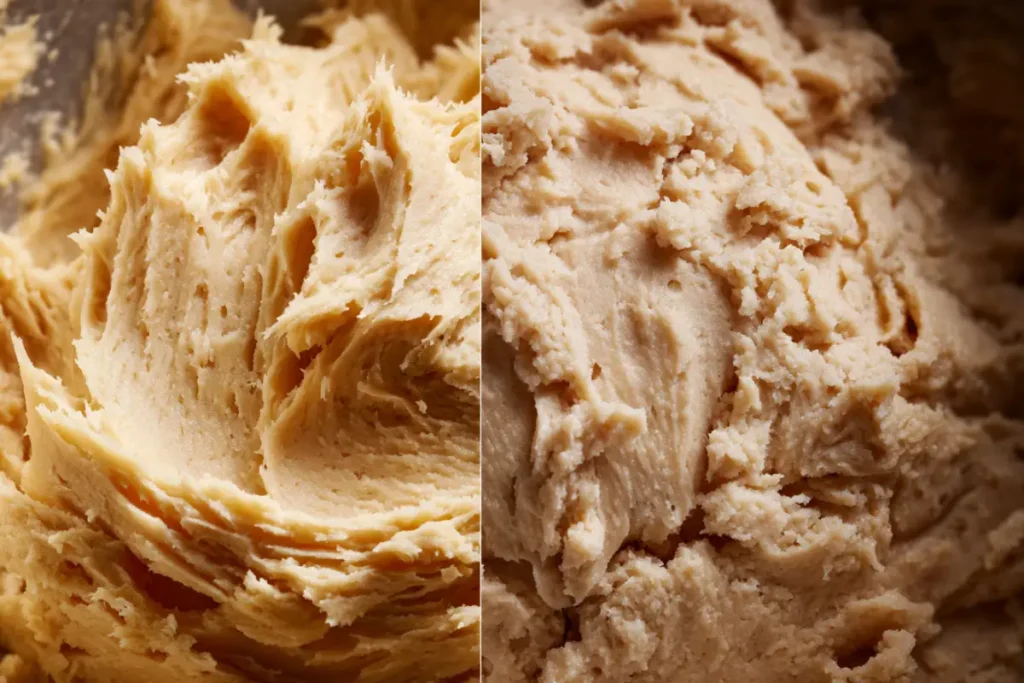
Texture is everything when it comes to edible cookie dough. If it’s too thin, it will feel more like pudding. Too dry, and it will crumble instead of scoop. You want that sweet spot—creamy, slightly firm, with just enough bite to mimic the real thing.
Here’s a simple fix-it guide:
| Problem | Cause | Fix |
|---|---|---|
| Too runny | Over-blending or excess liquid | Add more almond/oat flour |
| Too dry/crumbly | Too much protein powder/flour | Add 1–2 tbsp of cottage cheese or milk |
| Gritty texture | Large curds, under-blended | Blend longer, use small-curd |
Perfecting the texture not only improves taste, it makes the snack more enjoyable and satisfying to eat.
FAQs Answered About Cottage Cheese Cookie Dough
Can You Use Cottage Cheese to Make Cookies?
Yes, you absolutely can. Cottage cheese is a versatile ingredient that adds moisture, protein, and richness to baked cookies. While it’s most commonly used in no-bake cookie dough recipes, it also performs well in baked versions, especially when combined with oat or almond flour. The result is a soft, chewy texture with fewer calories and more nutritional value than traditional cookies.
Can Cottage Cheese Be Used for Baking?
Definitely. Cottage cheese works well in both savory and sweet baking. Its creamy consistency and mild flavor make it perfect for muffins, pancakes, casseroles, and even cheesecakes. When blended, it acts as a partial replacement for butter or cream, reducing fat while maintaining tenderness. It also helps keep baked goods moist and fluffy.
What Are 3-Ingredient High-Protein Cookies?
Looking for the simplest way to snack smart? Try this basic high-protein cookie formula:
3 Ingredients:
1 ripe banana
½ cup blended cottage cheese
1 cup rolled oats
Mash, mix, and bake at 350°F for 10–12 minutes. Add-ins like cinnamon or dark chocolate chips are optional but encouraged. These cookies are low in sugar, naturally gluten-free, and packed with energy-boosting carbs and protein.
Can You Add Protein Powder to Cottage Cheese?
Yes, and it’s actually a great way to enhance both the flavor and nutritional profile of your cookie dough. Vanilla, chocolate, or even peanut butter-flavored protein powders pair beautifully with cottage cheese. Start with 1 scoop per cup of cheese and adjust for texture. If the dough becomes too thick, add a splash of almond milk or water to balance it.
What Ingredients Should You Avoid in Cottage Cheese?
When choosing cottage cheese for cookie dough, avoid brands with:
Added sugars or syrups
Artificial flavorings or preservatives
Excess sodium (look for low-sodium options)
Fat-free formulas (they often lack creaminess and can taste chalky)
Stick to clean-label cottage cheese with minimal ingredients—ideally just milk, cultures, and salt.
Is Cottage Cheese Made of Casein or Whey?
Cottage cheese primarily contains casein, a slow-digesting protein that keeps you feeling full and supports muscle repair over time. It also contains small amounts of whey, which digests faster. This combination makes it a great all-around protein source, especially when used in post-workout snacks like cookie dough.
Cookie Dough Recap + Expert Finishing Tips
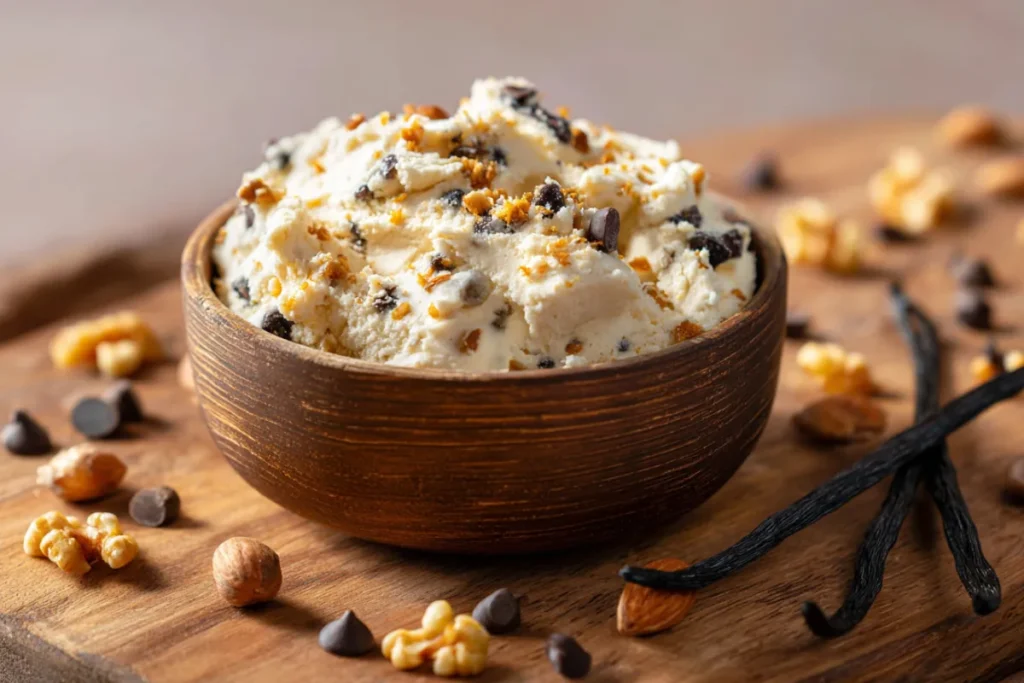
Recap of Benefits and Customizations
Cottage cheese cookie dough isn’t just a fleeting food trend—it’s a practical, protein-rich treat that supports your health goals while still delivering on flavor. Whether you’re looking to boost protein, cut down on processed sugars, or indulge without the guilt, this recipe checks every box.
We’ve covered how to:
- Make the perfect blend at home in under 10 minutes
- Customize it with add-ins like chocolate chips, peanut butter, and even protein powder
- Store it properly and avoid common kitchen mishaps
- Adapt it to vegan, gluten-free, or low-sugar diets
- Use it for pre- or post-workout fuel
This is the kind of treat you’ll actually look forward to eating—because it’s not just “healthy,” it’s satisfying, versatile, and joyfully indulgent.
Best Times to Enjoy Cottage Cheese Cookie Dough
Wondering when to reach for your next scoop?
- Post-workout: Support muscle recovery with slow-digesting casein
- Mid-afternoon: Curb cravings with balanced macros
- Evening snack: Satisfy your sweet tooth without the sugar crash
- Breakfast prep: Roll into energy bites for on-the-go mornings
This dough can fit seamlessly into your day, wherever a little sweet nourishment is needed.
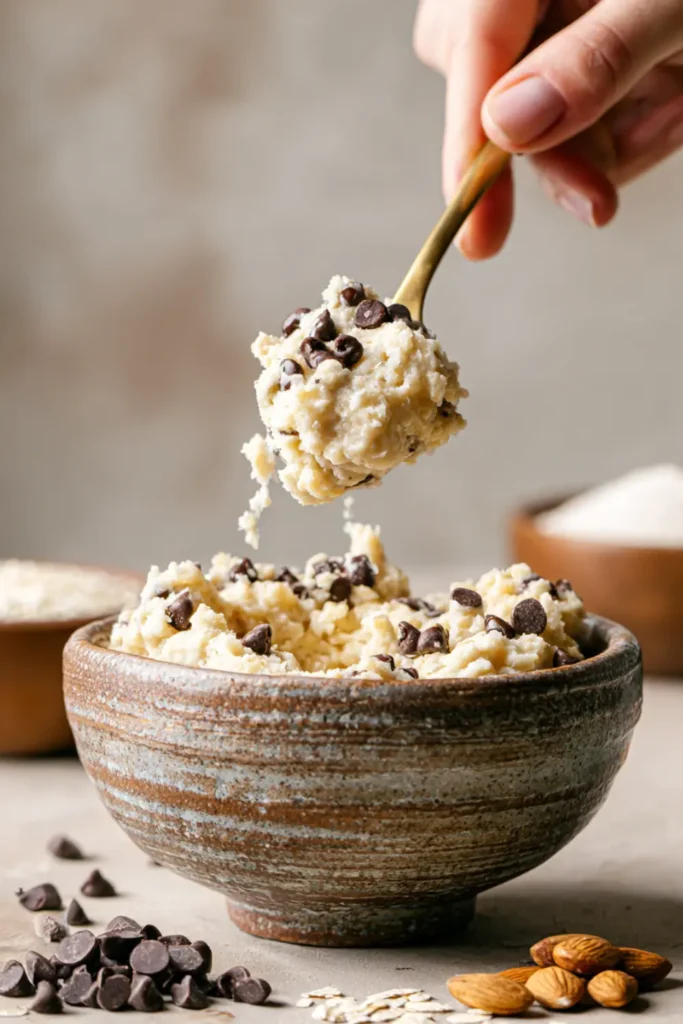
Cottage Cheese Cookie Dough
This creamy, high-protein cottage cheese cookie dough is the ultimate healthy, no-bake treat. Made in under 10 minutes with 5 simple ingredients, it’s a guilt-free way to satisfy sweet cravings.
- Prep Time: 10 minutes
- Cook Time: 0 minutes
- Total Time: 10 minutes
- Yield: 4–6 servings 1x
- Category: Dessert, Snack, High-Protein Treat
- Method: No-Bake, Blended
- Cuisine: American, Health-Conscious
- Diet: Vegetarian
Ingredients
1 cup low-fat or full-fat cottage cheese (small curd preferred)
2 tablespoons maple syrup (or honey)
1 teaspoon vanilla extract
1½ cups almond flour (or oat flour)
½ cup dark chocolate chips (dairy-free optional)
Optional: 1 scoop vanilla or chocolate protein powder
Optional: Pinch of sea salt
Instructions
Blend Base – In a blender or food processor, combine cottage cheese, maple syrup, and vanilla extract. Blend until smooth and creamy.
Mix Dough – In a bowl, combine almond flour (and protein powder, if using). Fold in the blended cottage cheese mixture until dough forms.
Add Chocolate – Stir in chocolate chips. Add a pinch of sea salt if desired.
Chill (Optional) – For firmer texture, refrigerate for 10–15 minutes before serving.
Serve – Scoop and enjoy as-is or roll into bites for easy snacking.
Notes
Use vegan cottage cheese for a dairy-free version.
Swap almond flour for oat flour if preferred.
Add cinnamon, peanut butter, or raisins for flavor twists.
Add protein powder to boost macros post-workout.
Nutrition
- Serving Size: ¼ cup (about 80–100g)
- Calories: 190 kcal
- Sugar: 3 g
- Sodium: 140 mg
- Fat: 11 g
- Saturated Fat: 3 g
- Unsaturated Fat: 7 g
- Trans Fat: 0 g
- Carbohydrates: 10 g
- Fiber: 2 g
- Protein: 12 g
- Cholesterol: 15 mg
Keywords: cottage cheese cookie dough, high protein cookie dough, edible cookie dough, no bake cookie dough, healthy cookie dough, protein dessert, cottage cheese dessert, cottage cheese snack, gluten free cookie dough, cottage cheese recipes, low sugar cookie dough, protein cookie dough recipe, healthy dessert recipe, post workout snack, clean eating dessert



This recipe is amazing quick, healthy, and so tasty!